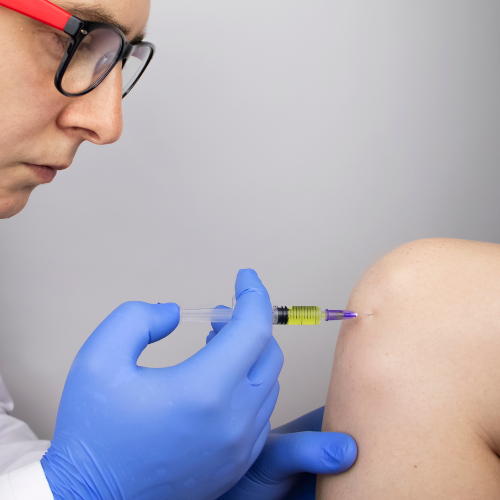The most common injections for Osteoarthritis of the knee include Cortisone, and hyaluronic acid, however there are new alternatives in regards to regenerative medicine. These treatments include prolozone therapy, Platelet rich plasma therapy (PRP), and human cellular tissue more commonly called mesenchymal stem cells.
Cortisone Injections
The most common injection for osteoarthritis of the knee is Cortisone. A cortisone shot usually contains an anesthetic for immediate pain relief along with a corticosteroid medicine for pain relief over time. Cortisone shots are recommended not only for Osteoarthritis, but also for psoriatic arthritis, rheumatoid arthritis as well as for tendonitis.
Results of corticosteroid injections for osteoarthritis of the knee typically depend on the reason for the treatment. Typically immediately after the Cortisone shot a person can have a short term flare up in pain, swelling and irritation for up to two days after the injection. Usually after 48 hours the person will see a decrease of pain, swelling and irritation that can last anywhere from 6 weeks to 6 months. For some patients they may even experience relief as quickly as a few hours.
The downside with cortisone injections for osteoarthritis of the knee is that it can make the pain better for a period of time, but seldom is it curative. Also cortisone shots have multiple side effects including cartilage damage, joint infection, nerve damage, necrosis or death of nearby bone, short term pain, swelling and irritation in the joint, short term increase in blood sugar, tendon weakening or rupture, thinning of nearby bone resulting in osteoporosis, short term facial flushing, thinning of the skin and soft tissue around the injection site, and possible whitening or lightening of the skin around the injection site.

Hyluronan Acid Injections sometimes called Viscosupplementation
Hyluronan acid injections, viscosupplementation or Rooster comb injections help ease pain in the knee by using a naturally derived viscous substance, with an active ingredient of hyluronan.
Hyluronic Acid injections for Osteoarthritis of the knee is a great alternative to corticosteroids and a lubricant and shock absorber. This substance helps reduce swelling and friction and allows the joint to glide easier. As we age, the lubrication in our knee decreases and this injection helps replenish some of that lost lubrication.
Hyluronin injections for osteoarthritis of the knee is usually administered in a series ranging from 3 to 5 depending on the product, usually spaced out 1 week apart. This series can usually be repeated every 6 months, however one of the downsides of this is that the more often this series is performed the less effective it is.
So for example the first time you get the series of injections a person can feel relief for a year maybe even two years. The second time they get the series of injections it might last 6 months and the third time they get the series it might only last a few months. This occurs due to continued degeneration over time, and the need for increased lubrication in an osteoarthritic joint.
Prolozone therapy treatments for Osteoarthritis of the knee
Prolozone is a homeopathic anti-inflammatory and vitamin/oxygen-ozone injection technique developed and pioneered by Dr. Frank Shallenberger. It works well for osteoarthritis of the knee as well as other issues with the knee including meniscal, tendon or ligament issues. Prolozone is excellent for all types of musculo-skeletal, connective tissue and joint pain issues. Prolozone is considered regenerative and corrects the problem.
Prolozone is a connective tissue injection therapy of collagen producing substances mixed with ozone gas. This is done by taking oxygen O2 and sending it through an ozone machine which changes the oxygen O2 to ozone O3, which is immediately absorbed by the body, especially connective and musculoskeletal tissue. Ozone therapy can reconstruct damaged or weakened connective tissue in and around the knee joint. Thus, ozone plus vitamins and homeopathic anti-inflammatories are injected into the damaged connective tissue in and around a joint to rebuild the damaged areas. By repairing the connective tissue, this is all that is needed to permanently reverse chronic pain.
The most common side effects of prolozone therapy are pain, soreness, and a sense of fullness at the injection site. Bruising and mild bleeding from needle trauma may also occur. Pain and soreness post injection typically last 24-72 hours. Patients are able to continue with normal activity after the injection.
PRP injections for Osteoarthritis of the knee
Another alternative to cortisone injections is Platelet Rich Plasma (PRP). PRP is a regenerative medicine treatment where we help the body jumpstart its own healing. Using a concentrated solution of blood platelets, which contain proteins and growth factors, PRP can be injected into the damaged area to promote healing.
PRP is prepared from your own blood, there is no risk of rejection or disease transmission and very minimal risk of infection. A local anesthetic is used before the injection for treating osteoarthritis of the knee so there is just mild discomfort during the procedure, similar to a flu shot. There may be mild swelling at the injection site after the procedure. However, the majority of patients are able to return to their usual activities with no down time.
Human Cellular tissue injections for Osteoarthritis of the knee
Another alternative to cortisone and one of the most powerful regenerative treatments for treating osteoarthritis of the knee is the use of Human cellular tissue previously knows as “mesenchymal stem cells.” These mesenchymal stem cells are taken from the Wartons jelly of the umbilical cord which is usually discarded after birth. This tissue is considered immune privileged because they rarely evoke an immune response in the human body. This reduces the risk of an adverse immune reaction. Amniotic tissue also has reported anti-inflammatory, antibacterial, and anti-fibrotic properties. Thus, no rejection of this product making it safe to use for treating osteoarthritis of the knee.
What makes this treatment even more amazing is these cells can differentiate into cartilage, bone, muscle, ligament as well as a host of growth factors, cytokines, and proteins that eliminate inflammation and provide the tissue with the ideal conditions for regeneration.
Thus, the only side effect that can occur from this type of treatment is, mild swelling at the injection site after the procedure. However, the majority of patients are able to return to their usual activities with no down time.
What are the recommendations after an injection for Osteoarthritis of the knee?
It is recommended that you refrain from any high level activities using your knee for approximately 48 hours. Routine activities including walking are permitted.
After any of the above injections, it is important to massage the area or move it to disperse the medication or product. The first two days following an injection, you should not participate in strenuous activities. Avoid activities such as jogging, soccer, tennis, heavy lifting, or standing on your feet for a long time.
Which injection for Osteoarthritis of the knee is right for me?
Corticosteroids do not work for all patients, and when they are effective the results may vary. Usually about 40% of patients report feeling better after receiving cortisone shots for the knee. Also Corticosteroids have a multitude of side effects and long term problems that can accelerate degeneration in the already arthritic knee. Thus, treatments like Corticosteroids are avoided at Waters Edge Medical clinic, our goal and purpose is to help heal and regenerate the affected arthritic knee joint.
Hyluronic acid is a great alternative for someone who is suffering from early degenerative changes, however is the problem is more severe we highly recommend treatments with PRP or human cellular tissue. It is best to schedule a consultation and evaluation with one of our professionals who can examine, evaluate and take a look at imaging to see which option would work the best for osteoarthritis of the knee.

